New, Fourth Mammoth Tooth Found in Mohovo near Ilok
August 2, 2022 – Maybe you have never heard of Mohovo, and maybe you know that they keep finding mammoth teeth there... There is really no in-between. A new, fourth mammoth tooth was found on Saturday, 30th July.
As SiB reports, ten years after he found the first mammoth tooth in his village, Goran Popović from Mohovo found another, fourth, mammoth tooth on Saturday.
He informed his friends and the public about the phenomenal discovery by posting on Facebook, stating that he was filled with happiness, emotions, and optimism.
"I had that instinct again, walked through our beautiful village, and then it happened – the fourth mammoth tooth. All of a sudden, a part of the hill collapsed and the tooth just popped out. Now I'm completely convinced that this is no longer a coincidence", he wrote and invited everyone to join in and help, because a lot of support is needed to start the systematic search of the location.
SiB spoke about this discovery with Goran, who, still under a strong impression, said that not a single find was the result of purposeful digging and searching, but that he found each tooth completely by accident.
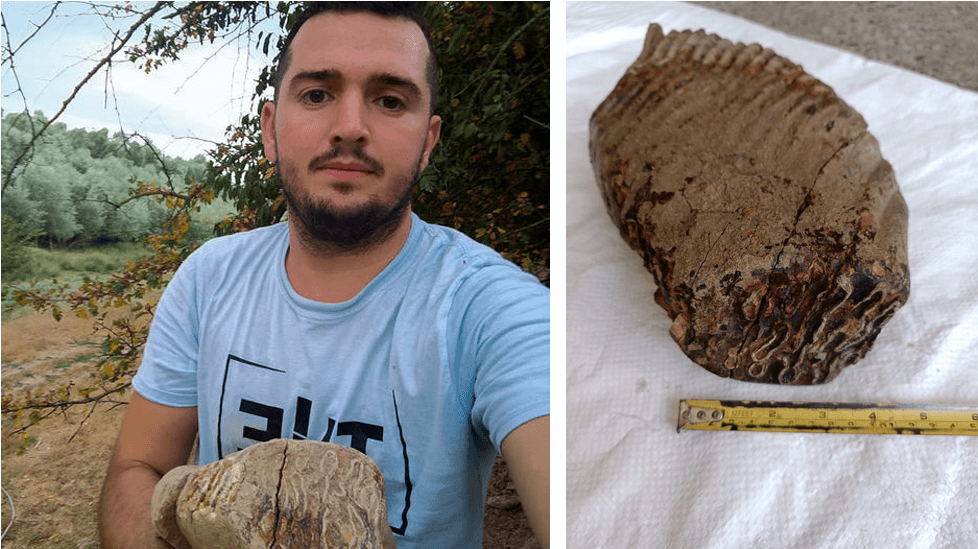
Photos by Dolina Mamuta
“Last year, the Minister of Culture, Nina Obuljen Koržinek, visited the site of the discovery, the county and city authorities came, and we received promises from all of them that they would do everything in their power to start archaeological research. I know that the activities in the wider Vukovar area focus on Vučedol, but I believe that the finding of another tooth will motivate the authorities to pay attention to Mohovo as well. It would be an important step in the promotion of our small village and it would certainly make it more attractive not only in terms of archeology but also in terms of culture and tourism”, said Popović.
The relevant ministry and the Ilok City Museum were immediately informed about the discovery, as well as the City of Ilok, and the Vukovar-Srijem County. He emphasized that this place with only two hundred inhabitants obviously hides great secrets that experts need to investigate. It all started in the fall of 2012 when, while digging a septic tank in an orchard, he found the first fossil remains of a woolly mammoth, and a discovery was made four years later in another location. Goran states that short research, in addition to the woolly mammoth and the woolly rhinoceros, led to the discovery of fossil remains of a hyena, a wild horse, and a bison. Four years after the second discovery, there was a third one, when the fossil remains of a mammoth were found again near the village pond. Realizing the potential hidden in their village, several young residents of Mohovo founded the association Dolina Mamuta (Mammoth Valley). They organised workshops, installed a straw sculpture of a woolly mammoth, a woolly rhinoceros, and a hyena in the village centre, and launched the events "Advent in Mohovo" and "Mammothfest", the second edition of which is planned for this October.
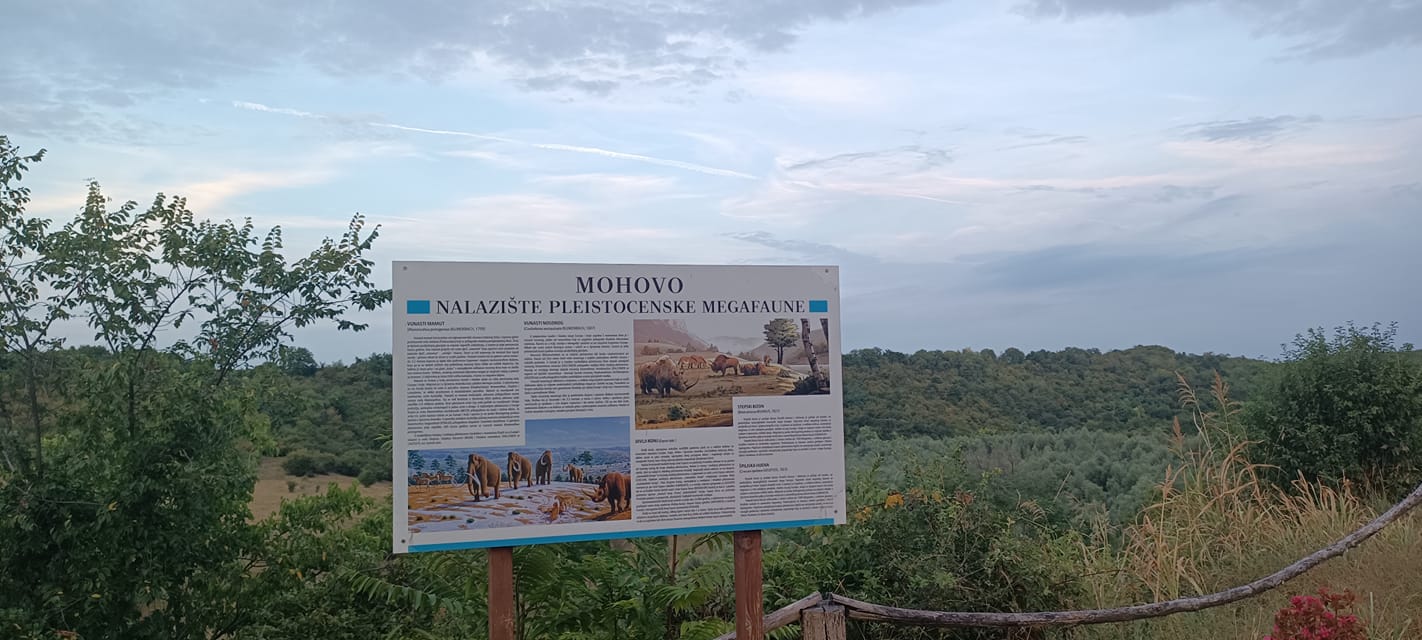
Photo by Dolina Mamuta
“The creation of a sculpture made of solid material is nearing completion, for which we were provided funds through donations after the straw sculpture was destroyed in a fire.
For the second "Mammothfest", we plan to organize an exhibition about the findings so far and additionally motivate the authorities for systematic research” he stated.
For more, check out our lifestyle section.
Osijek Ferivi Half Marathon on Saturday to Welcome 1,250 Participants from 11 Countries
April 6, 2022 – On Saturday, April 9, the annual Osijek Ferivi Half Marathon will be held, with a range of events for professional and recreational athletes alike.
As SiB writes, the citizens' race and relay race will start at 10.00 am on Ante Starčević Square, while children's races will start at 5.00 pm on the promenade of the upper Drava coast, west of the winter port. A press conference was held yesterday on the central city square in Osijek, the Ante Starčević Square, at which the 18th Osijek Ferivi Half Marathon was announced, a traditional event that will this year take place on Saturday, April 9.
This is the largest and most visited race in the Slavonia and Baranja region, which has been held since 2005 and brings together many athletes, recreationists, and other citizens who want to enjoy running through the streets of Osijek. In addition to the half marathon (21.1 kilometers), there is also a 5km citizens’ race "Are you running, lega?", as well as the men's, women's, and mixed relay races of 3 x 7 kilometres and children's races from 300 meters to 1 kilometer. The organizer of the event is the Marathon Club Hrvatski Sokol from Osijek, and the sponsors are the Osijek-Baranja County, the City of Osijek, the Tourist Board of the City of Osijek, and the Croatian Red Cross.
"The pandemic finally allowed us to gather in large numbers and continue to socialize outdoors through running, cycling, walking, and other sports. I urge our citizens to come to the race because the contemporary lifestyle means a lot of sitting and using cars or public transport, so we need to practice sports. I am sure that everyone who runs the race for the first time will be excited for the next Osijek Ferivi Half Marathon," said the prefect Ivan Anušić.
The citizens' race and the relay race will be starting at 10.00 am on Ante Starčević Square, while the children's races will start at 5.00 pm on the promenade of the upper Drava coast, west of the winter port. More than 1,250 competitors have already registered, not only from Croatia but from 10 other countries (USA, Sweden, Norway, Serbia, Slovenia, Northern Macedonia, Hungary, Germany, Austria, Bosnia and Herzegovina).
The Osijek Ferivi Half Marathon is not just a sporting event, but a combination of sports, entertainment, culture, and tourism, and contributes to the branding of Osijek. What is especially enriching about this event is that not only athletes but also recreational athletes take part, and even more so that children do. The city will continue to support this event", said the mayor of Osijek Ivan Radić.
He added that Osijek cares about its athletes and sports facilities and that this year Osijek will acquire a real Olympic swimming pool (at the Copacabana pools) for the first time, as well as introduce scholarships for athletes of the 5th and 6th categories while striving to raise sports and recreation to a higher level.
The Osijek Ferivi Half Marathon is an event that has been organized by the Marathon Club Hrvatski Sokol since the first race. The Club entered into a partnership with Ferivi & Co d.o.o. in 2008. and the race has since been called the Osijek Ferivi Half Marathon. Last year, the event had a record number of participants and outstanding accompanying content.
To read more about sports in Croatia, follow TCN’s dedicated page.
OPG Čudesna šuma: Paradise Reimagined in Beautiful, Traditional Baranja
May 13, 2021 – OPG Čudesna šuma: How an unexpected turn of events helped world-renowned photographer Mario Romulić realise his lifelong dream.
War and genocide and the aftermath. Famine. Disease. Death. In a former life, harrowing images filled the lens of internationally renowned photographer Mario Romulić. But thankfully, we're now far from such scenes.
In fact, at OPG Čudesna šuma - Mario Romulić's home and family farm - we're pretty much far from everything. One other eco-farm is his only neighbour. Well, unless you count the llamas the Romulić family keep out back. Occasionally, through the rich green of surrounding trees, you see birds flying above the branches. Probably they're toing and froing from Kopački rit. The nearby Nature Park is less than a kilometre from OPG Čudesna šuma. Famously, the wetlands are home to over 250 species of birds. They are also the reason why Mario Romulić is here.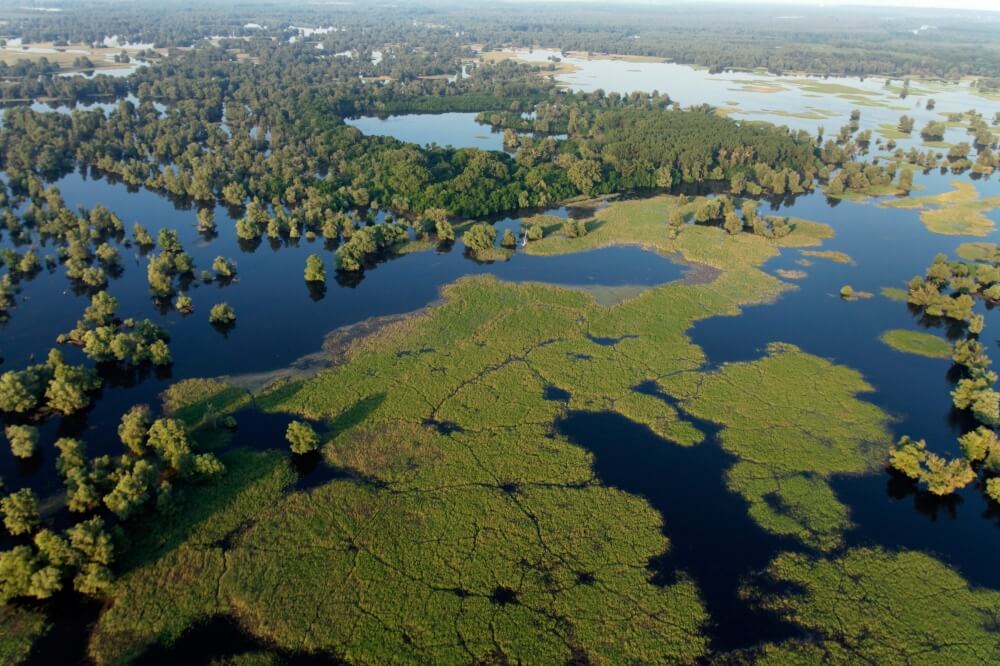 Kopački rit Nature Park © Kopački rit Nature Park.
Kopački rit Nature Park © Kopački rit Nature Park.
“Back then, I was very occupied with Kopački rit,” remembers Mario of the time, 21 years ago, when he moved to what is now OPG Čudesna šuma. “I was working as a cameraman for people like Reuters, all over the world. The assignments would last 7-10 days and I'd be in places like Afghanistan, Rwanda, Congo, Liberia, Bosnia. It was often quite dangerous. For the next 20 days, I would spend a lot of time in Kopački rit, trying to calm my nerves. It was something like a cure after seeing all these horrible scenes. Eventually, instead of travelling every day from my home in Osijek to Kopački rit, I decided to try and find something close by. And this is what I found.”
Just as this beautiful, natural landscape in Bilje, Baranja once served as a peaceful getaway for Mario Romulić, his OPG Čudesna šuma today does the same for others. Because, after dreaming for two decades of turning this blissful plot and homestead into a forest farm and eco-village, Mario Romulić is finally turning that vision into a reality.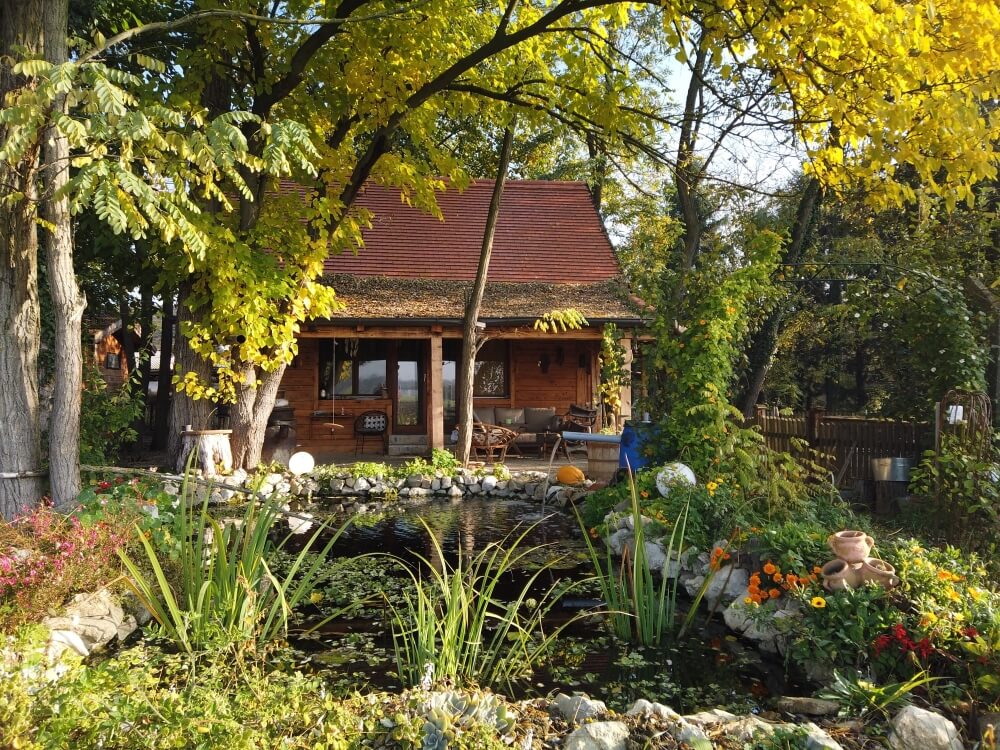 The impossibly pretty OPG Čudesna near Kopački rit Nature Park, Bilje Municipality, Baranja © OPG Čudesna šuma.
The impossibly pretty OPG Čudesna near Kopački rit Nature Park, Bilje Municipality, Baranja © OPG Čudesna šuma.
“Because of my job - first, travelling all around the world, then travelling Croatia - I did not even have much time to think about it, let alone do it,” says Mario. “But, then Corona came. Finally, I found myself at home. At last, I had time to work on my dream.”
OPG Čudesna šuma in the Month of Baranja Cooking (Mjesec baranjske kuhinje)
A group of 30 or so are Mario's guests today at OPG Čudesna šuma. They're here for a presentation of speciality cooking. It's the grand finale of the Month of Baranja Cooking (Mjesec baranjske kuhinje).
Over previous weeks, OPGs from all across the region have welcomed guests to try goulash, soups, stews, perklet and other traditional foods of the area. While visiting, they've been embraced by the beautiful landscape of Baranja. Not only have they discovered how this delightful, distinct cuisine tastes, but also they've learned exactly how it's prepared. However, they've evidently saved the best for last. On the menu today, river fish inventively cooked, accompanied by a riotous rainbow of seasonal vegetables.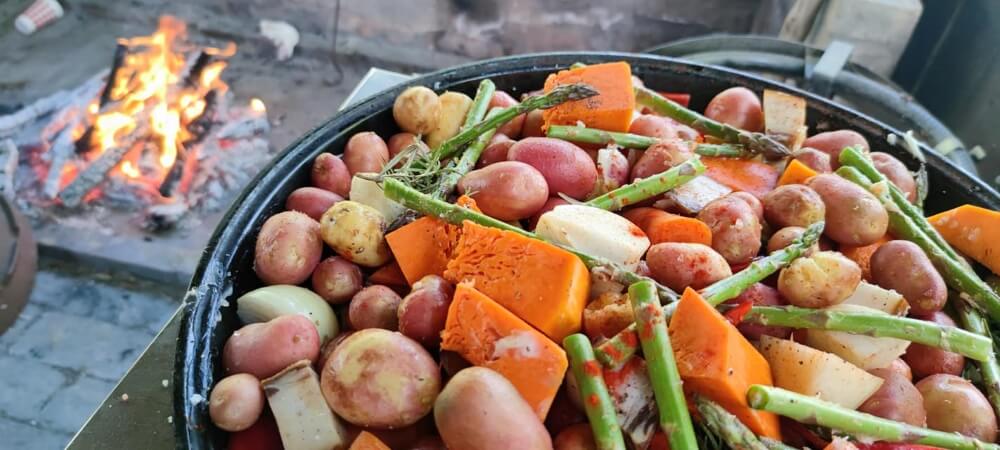 Seasonal vegetables of Baranja in springtime at the Month of Baranja Cooking (Mjesec baranjske kuhinje) © OPG Čudesna šuma.
Seasonal vegetables of Baranja in springtime at the Month of Baranja Cooking (Mjesec baranjske kuhinje) © OPG Čudesna šuma.
It's a beautifully sunny day, right at the start of May. It depends on your preference, but looking across this happy vista in the glorious sunshine, it's difficult to imagine this not being the perfect time to be in Baranja. Young children are raised to chest height by their parents so they can meet Mario's free-roaming llamas face-to-face. The children's faces flit between surprise, curiosity and delight. The llamas return their stare. They're used to welcoming new guests.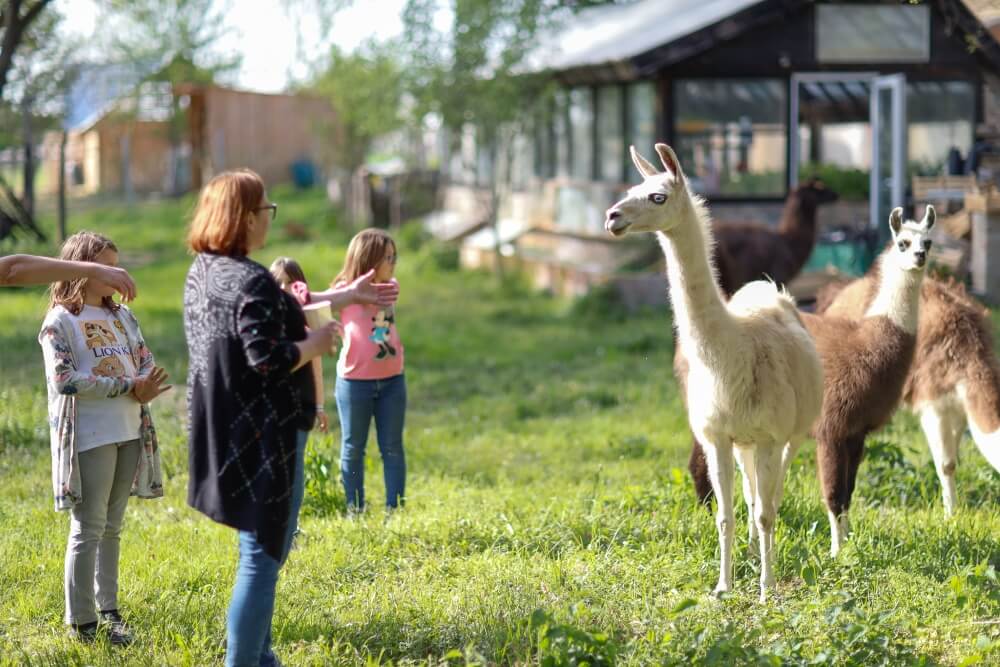 Meeting the Romulić family llamas at OPG Čudesna šuma © Turistička zajednica Općine Bilje - Kopački rit.
Meeting the Romulić family llamas at OPG Čudesna šuma © Turistička zajednica Općine Bilje - Kopački rit.
Partially shaded by trees, the smiling adult guests sit casually on wooden benches around a central, outdoor cooking area. Several open fires display a range of traditional cooking methods. Steam rises from a cast-iron stove suspended over one. Beneath the vapours, you can make out the dish is fish paprikash. It's unmistakable because of the deeply red coloured bubbles, a result of generous amounts of paprika.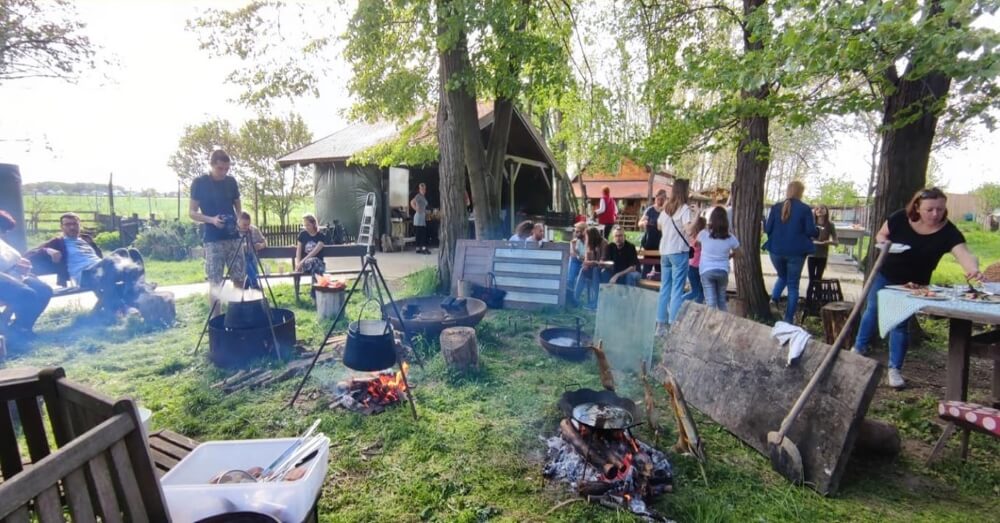 Guests enjoy a warm springtime day at OPG Čudesna šuma during the Month of Baranja Cooking (Mjesec baranjske kuhinje), as fish paprikas cooks over an open fire © OPG Čudesna šuma.
Guests enjoy a warm springtime day at OPG Čudesna šuma during the Month of Baranja Cooking (Mjesec baranjske kuhinje), as fish paprikas cooks over an open fire © OPG Čudesna šuma.
A huge bag of this paprika sits propped up, close by. It's from another organic OPG, just a kilometre or so from here. The colour is vivid, impossibly red, unrecognisable from anything store-bought. At the next fire, pike impaled on wooden sticks are placed far enough from the flickering flames so they cook slowly and do not burn.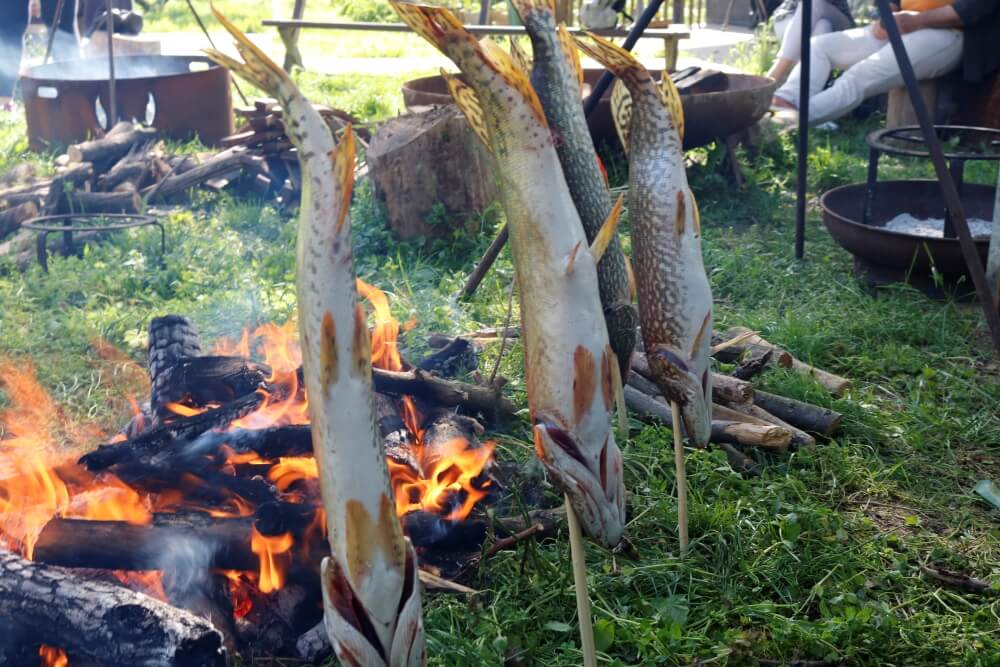 Pike impaled on sticks, cooking by an open fire at OPG Čudesna šuma @ Marc Rowlands.
Pike impaled on sticks, cooking by an open fire at OPG Čudesna šuma @ Marc Rowlands.
In the outdoor kitchen, Mario Romulić's co-chefs prepare an unending supply of fish dishes and vegetables. Carp, catfish, trout, bream. There's a bounty of fresh asparagus. It's that time of year. With the restraint of experience, they've cooked it perfectly. After the crunch of the bite, the flavour explodes. They're seasoned simply – delicious olive oil and sea salt.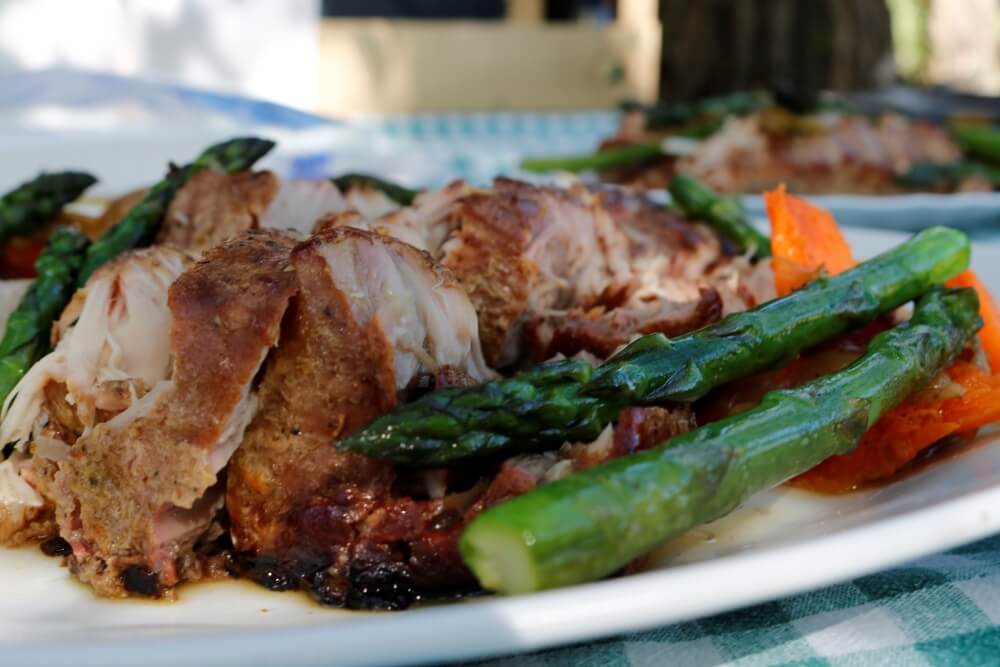 Seasonal asparagus, perfectly cooked, served with smoked river fish © Marc Rowlands.
Seasonal asparagus, perfectly cooked, served with smoked river fish © Marc Rowlands.
A group of peers – accomplished chefs from Osijek-Baranja restaurants – peak over the shoulders of Romulić's co-chefs. They're admiring the inventive techniques employed. Although, being chefs, they can't help themselves. They end up briefly forgetting their families in order to help out.
Mario Romulić, the host with the most
 Mario Romulić © Turistička zajednica Općine Bilje - Kopački rit.
Mario Romulić © Turistička zajednica Općine Bilje - Kopački rit.
After all the guests arrive, Mario Romulić holds court. Cheerily he welcomes us all to OPG Čudesna šuma and the event. Without question, the success of rural, village tourism depends on the personalities of the hosts. It's no good plonking a group of visitors in a pretty place and throwing some food in front of them. We've all seen trees, grass and food before. Rural tourism is not just about the place, it's about the experience, the ambience. And, especially, it's about the people.
Hands down, the OPGs of Slavonia and Baranja are the best in Croatia at this. The folks here are famous for their friendliness, warm welcome and big personalities. And, Mario Romulić has one of the biggest of them all.
In the research for this reportage, looking back at archive pictures of Mario Romulić is startling. During his years spent as an international photographer, he himself has been photographed many times – on assignment in distant countries, at the opening of exhibitions that have showcased his celebrated work. In most, there's an intensity to his stare. It's sometimes difficult to look at. He looks like a man who has tales you never want to hear, like a man who has seen too much.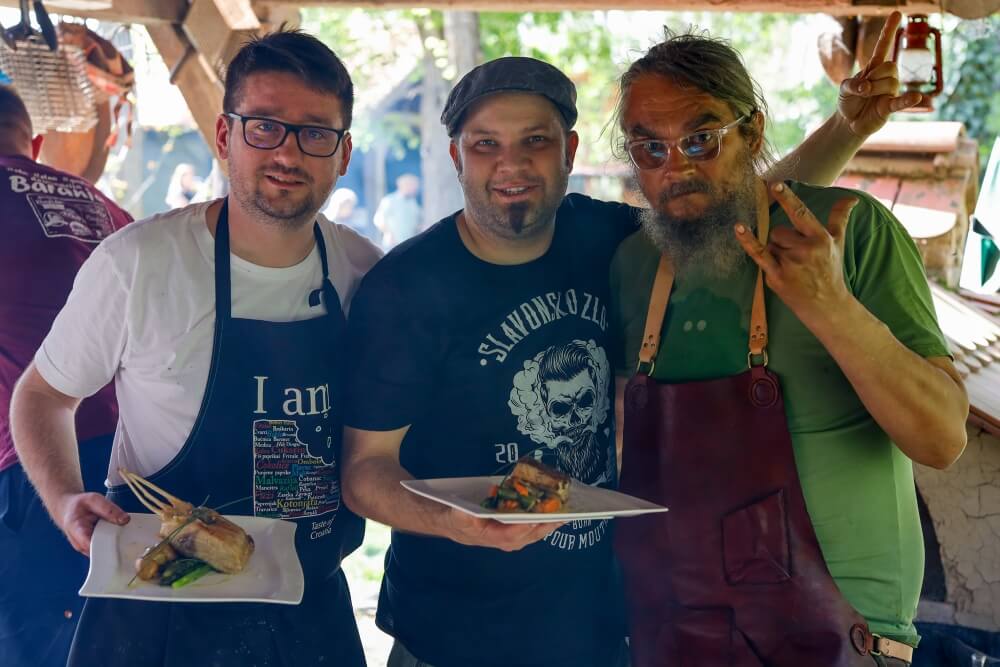 (L- R) OPG Čudesna šuma co-chef at the event Mihael Tomić, renowned Osijek chef Ivan Đukić currently of Osijek's Lipov Hlad and a happy Mario Romulić © Turistička zajednica Općine Bilje - Kopački rit.
(L- R) OPG Čudesna šuma co-chef at the event Mihael Tomić, renowned Osijek chef Ivan Đukić currently of Osijek's Lipov Hlad and a happy Mario Romulić © Turistička zajednica Općine Bilje - Kopački rit.
By comparison, the Mario Romulić that welcomes us at OPG Čudesna šuma today is unrecognisable. Sure, there's a little more grey to his long hair and beard but, otherwise, he looks incredibly healthy and happy. The intense stare is gone, replaced by a warm, wide smile that shows across his entire face. Even in early May, he has a darkened skin tone, the telltale signs of a man who spends much of the day outdoors. Romulić's enthusiasm for his guests and the event is palpable. After his sincere welcome, this enthusiasm is immediately transferred to each of his guests.
Mrs Romulić ensures everyone's glass is overflowing with wine or juice. One of Mario's teenage sons helps out with the food, while the other is taking photographs of the event. Well, someone has to do the photography now that dad wants to be a chef and host! Mario himself is engulfed in smoke. Among the other duties he's assumed today, Mario is tending a smoker. Without a doubt, this is the most revelatory cooking method we meet today.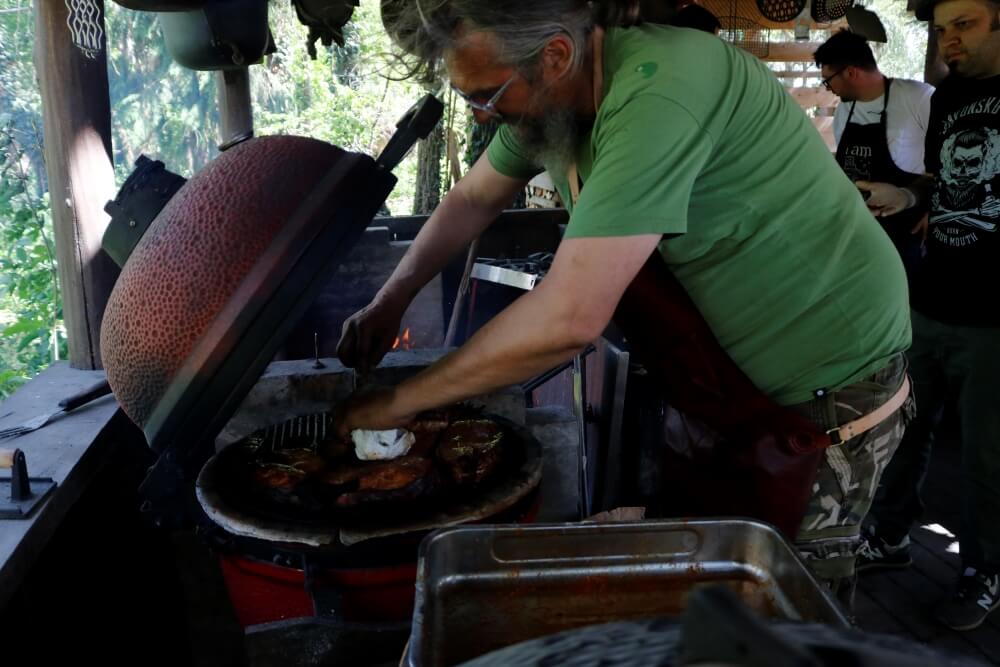 Mario Romulić tends to smoked river fish, a revelatory gastronomic experience at OPG Čudesna šuma © Marc Rowlands.
Mario Romulić tends to smoked river fish, a revelatory gastronomic experience at OPG Čudesna šuma © Marc Rowlands.
Smoked fish of Slavonia and Baranja at OPG Čudesna šuma
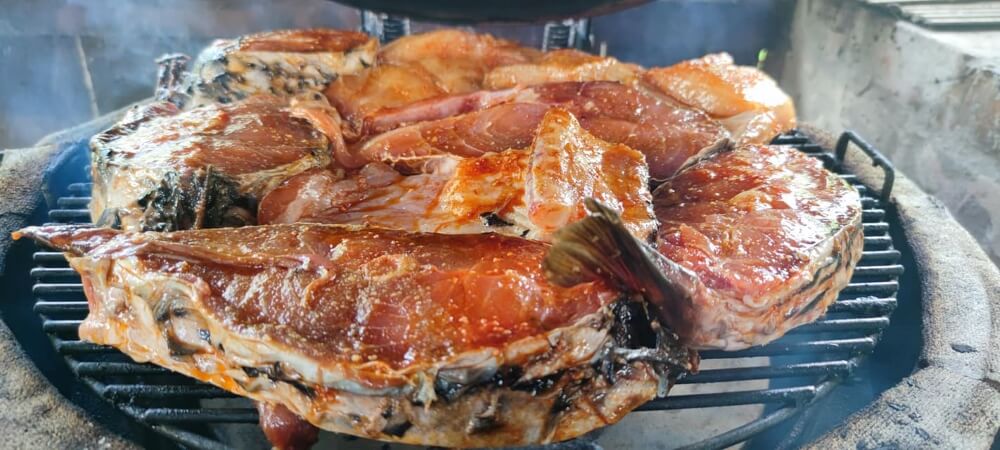 An American-style smoker, loaded with river fish. TOP TIP: A great way to stop fish sticking to the grill of your barbecue or smoker is to place them on top of a layer of lemon slices © OPG Čudesna šuma.
An American-style smoker, loaded with river fish. TOP TIP: A great way to stop fish sticking to the grill of your barbecue or smoker is to place them on top of a layer of lemon slices © OPG Čudesna šuma.
“We do have smoked fish here, but not in this way,” he says. “This is more like an American grill. I never heard of anyone trying Baranja cooking like this. Actually, I never heard of anyone nearby who has a smoker like this. The first time I tried stuka (pike) in the smoker, that was unbelievable. It's incomparable, really special.” Exquisite presentation of river fish by the enthusiastic team of OPG Čudesna šuma © Turistička zajednica Općine Bilje - Kopački rit.
Exquisite presentation of river fish by the enthusiastic team of OPG Čudesna šuma © Turistička zajednica Općine Bilje - Kopački rit.
“In Slavonia and Baranja, there are just a few ways we usually cook our river fish - carp on sticks, fish paprikash, perklet and fried fish. So, we tried something new, to expand the palette. For instance, almost nobody eats Babuška (a type of carp). They feed it instead to their pigs. It costs 5 kuna a kilo! But, if you cook it in this completely natural way, it's delicious.”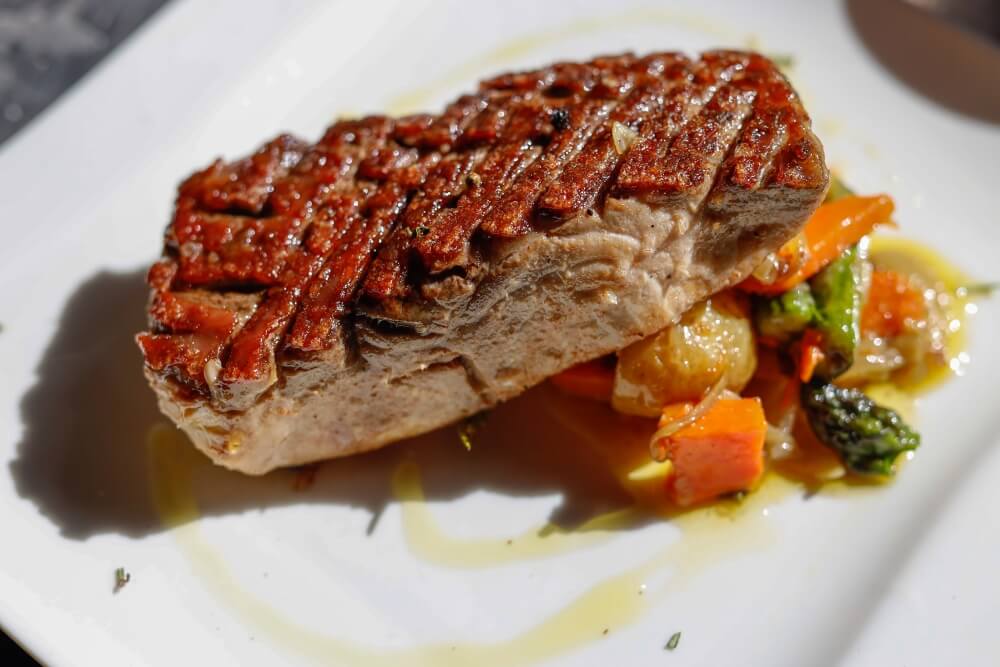 More river fish, cooked by the team of OPG Čudesna šuma © Turistička zajednica Općine Bilje - Kopački rit.
More river fish, cooked by the team of OPG Čudesna šuma © Turistička zajednica Općine Bilje - Kopački rit.
He's not wrong. Today's mountain of different smoked fish is the talk on most of the adult lips. The rich flavours surprise. Compliments and returns for second helpings ensue. Mario stands to one side, happily watching as his smoked fish secret escapes. In the future, he plans similar events based on other regional foods - Black Slavonian pig, wild meats like deer or boar. Eventually, in the seven hectares of land he owns here, he would like to expand OPG Čudesna šuma as an eco-village, with beds for visitors, a natural swimming pool and then surround it with a food forest. Big plans. It looks as though the camera may stay more permanently in the hands of his son. Because it's difficult to imagine Mario Romulić leaving his happy place and the realisation of his long-held dream. Mario Romulić in his happy place, with a friend © OPG Čudesna šuma.
Mario Romulić in his happy place, with a friend © OPG Čudesna šuma.
Both the author and Total Croatia News would like to thank the following for their invaluable help in creating this article: Ivana Jurić and the Tourist Board of Osijek-Baranja County, OPG Čudesna šuma, Mario Romulić and family, Renata Forjan and Turistička zajednica Općine Bilje - Kopački rit and Domagoj Butković of expert travel guides to Slavonia and Baranja, Kulen travel.
Croatian Fis Paprikas Listed Among Top 100 Traditional Dishes in the World!
October 17, 2020 – Food guide TasteAtlas published the list of the best traditional dishes in the world and Croatian fis paprikas is the only Croatian dish that made it to the top 100.
As TasteAtlas announces, the day of the local food celebration has come! The list of the top 100 traditional dishes in the world for 2020 has been published, and this year, Croatia can boast one specialty that made it to the list – fiš paprikaš (fish stew), which took 90th place among the great competition of world-famous specialties, such as Japanese sushi, Israeli falafel, and Spanish paella.
This traditional specialty comes from the eastern part of Croatia, from the regions of Baranja and Slavonia, and is influenced by neighboring Hungary. Their popular dish called paprikás csirke (chicken stew) also made the list, taking only two places ahead of Croatian fiš paprikaš.
"Fiš paprikaš (or hal paprikas in Hungary) is a traditional stew cooked in a big cauldron over an open fire. This spicy fish stew is traditionally made with a variety of freshwater fish such as catfish, starlet, pike, and carp. The stew is heavily flavored with large amounts of the region's staple – ground red paprika, which can range from mild to very hot. Fiš paprikaš is often served with homemade noodles, and it is so popular in the region that there are numerous fiš cooking competitions organized throughout the year. The dish is traditionally accompanied by hot ground paprika on the side so each person can increase the spiciness according to personal preferences," reads the description of fiš paprikaš on TasteAtlas.
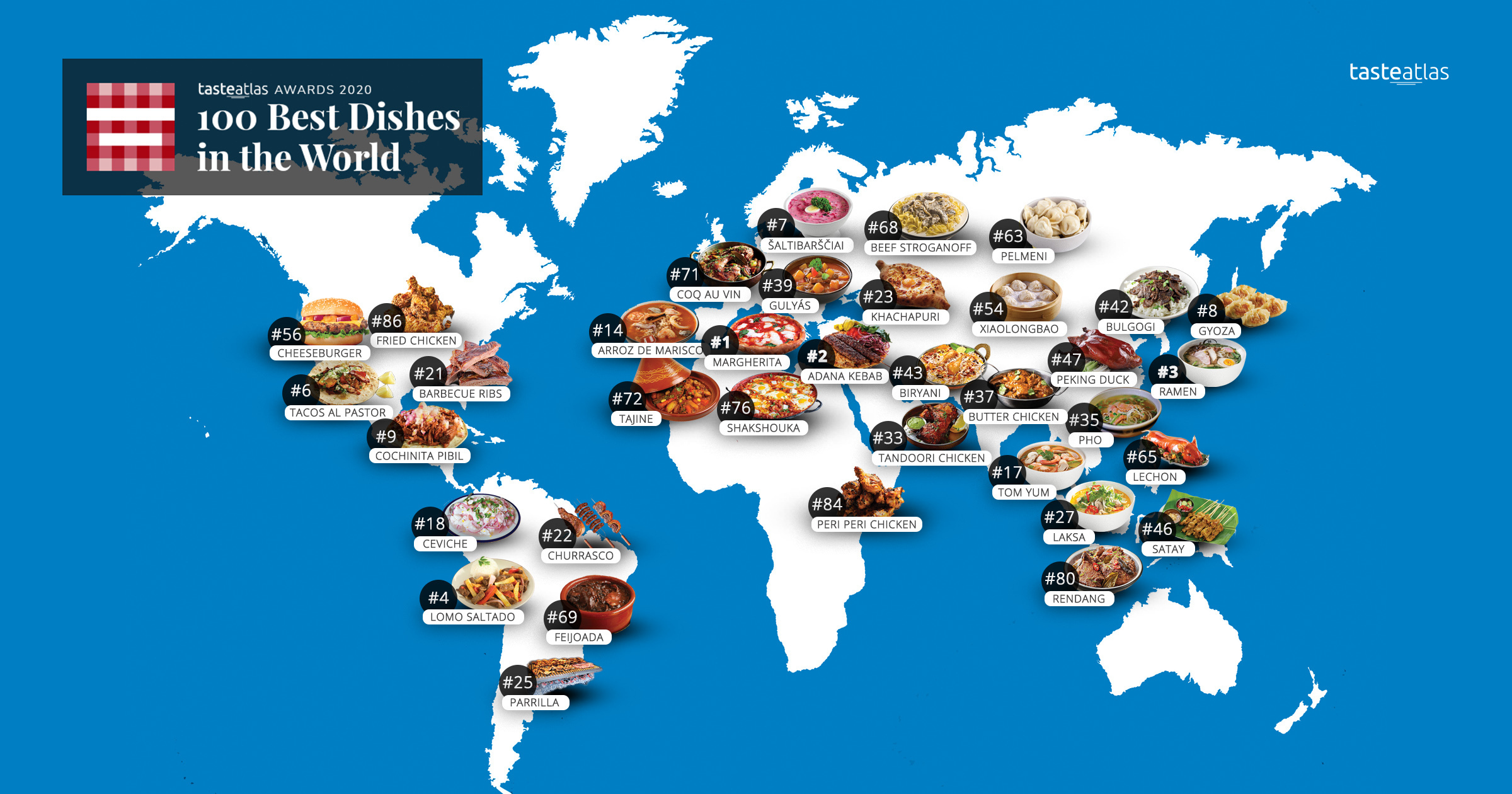
The map of the best traditional dishes in the world / Source: TasteAtlas
However, this is not the first time TasteAtlast recognized the quality of fiš paprikaš. It took the 3rd place on the list of most popular freshwater fish dishes in the world. It is also included on the list of most popular fish dishes in the world where it stands in 30th place. On the list of most popular seafood in the world, it comes in 82nd place, and it is 96th place on the list of most popular stews in the world.
Considering the most popular Croatian fish dishes and seafood, it takes 2nd place, along with other fish specialties from Baranja and Slavonia, namely, pijani šaran (drunken carp) and perklet od soma, likewise influenced by Hungary.
TasteAtlas traditional food awards 2020 listed the top 100 world-famous dishes according to 63,402 valid ratings on TasteAtlas, along with the restaurants where you can taste the best version of each dish. And is there a better place to taste this traditional Croatian dish than the heart of Baranja? The title of the best restaurant for tasting fiš paprikaš went to the restaurant "Citadela" in Vardarac near the town of Bilje and the Nature Park Kopački Rit, although other traditional food restaurants in the area are not far behind.
Interestingly, Bosnian traditional dish ćevapi took the 30th place on this list, ahead of Thai pad thai, Italian spaghetti aglio e olio, and American fajitas.
Italian traditional pizza Margherita took first place, and the other specialties of Italian cuisine such as risotto alla Milanese, lasagne alla Bolognese, pasta Carbonara, and tortellini in brodo, unsurprisingly dominated the list.
You can also check how many of the 100 best traditional dishes you have tried by signing up and marking the food tried.
Taste Atlas is a global-local food interactive map that serves as a food guide for those who want to know more about the local food from all over the world, as well as the places where you can try the best of it. It was founded two years ago by Croatian Matija Babić, who is also a founder of one of the most popular Croatian news portals, Index.hr.


